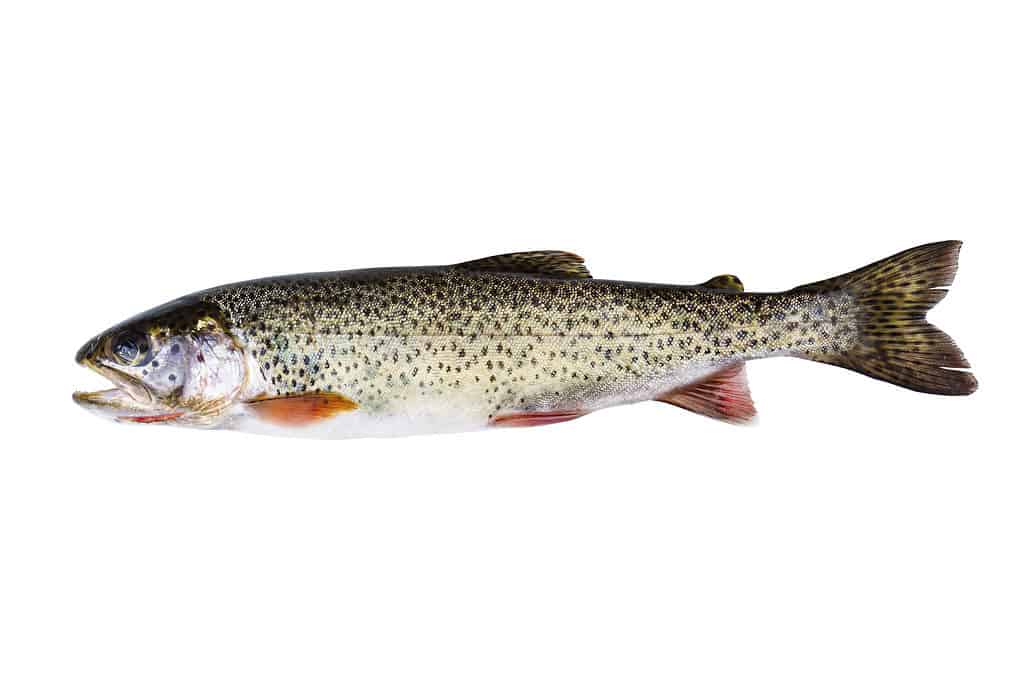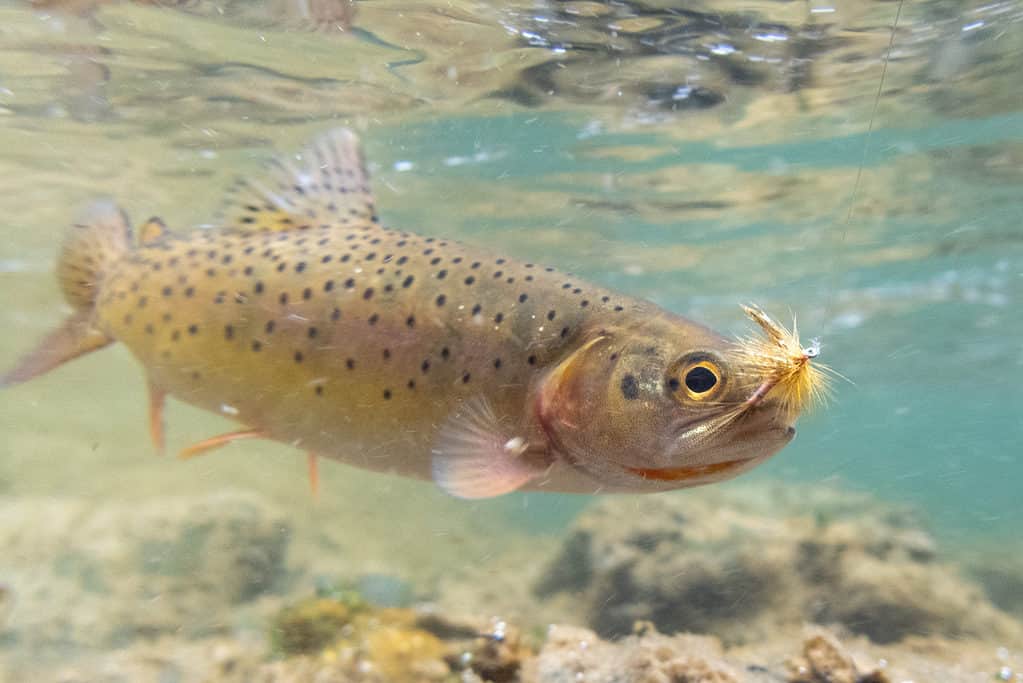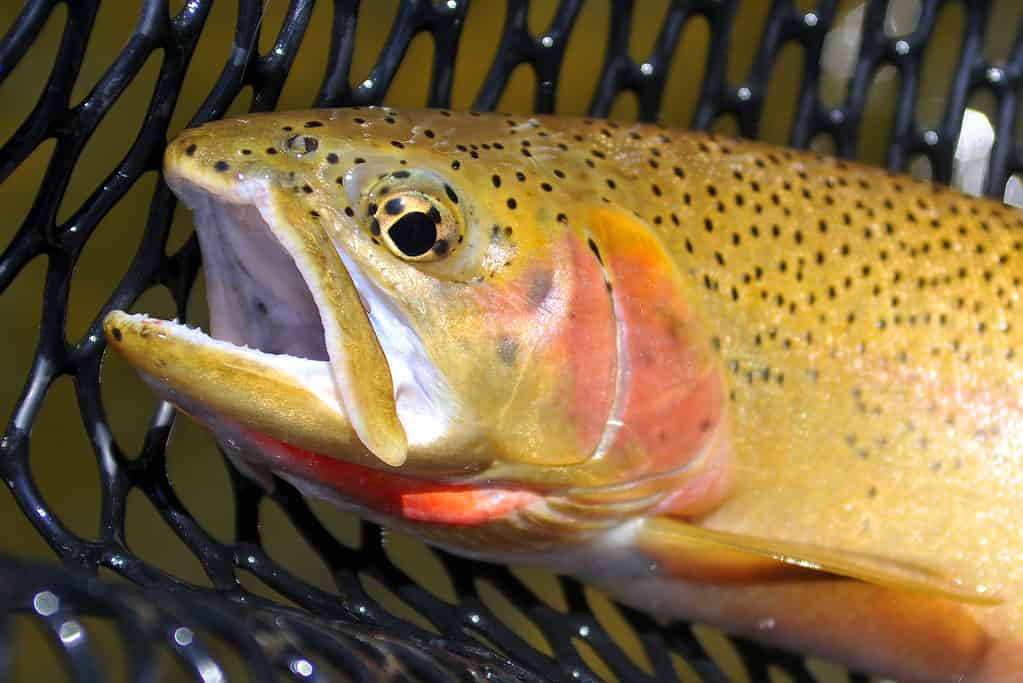Snake river cutthroats are a lot of fun for anglers to catch. They are shiny fish native to the Snake River. These fish are one of the easiest trout fish to catch because of their abundance. Are you interested in making a new state or world record? Follow along to discover the largest snake river cutthroat ever caught in Colorado.
The Largest Snake River Cutthroat Ever Caught in Colorado
Colorado has some impressive fishing records. The largest snake river cutthroat ever caught in Colorado was 33 inches long and weighed 17.16 pounds. In 2005, Rob Peckham caught the impressive fish below Green Mountain Dam. He expertly used a rainbow-colored Rapala on spin-casting gear. It surprised him when he reeled in a large Snake River cutthroat because they aren’t native to Blue River. While some Snake River cutthroat trout fish reach over 20 pounds, 17.16 pounds is still impressive!

The largest snake river cutthroat ever caught in Colorado was caught in 2005 and weighed 17.16 pounds.
©iStock.com/tab1962
Where is the Green Mountain Dam Located on a Map?
The Green Mountain dam and reservoir is an impressive engineering feat that spans across the Blue River in Colorado. Located in Summit County, it can be found approximately 12 miles northeast of the town of Silverthorne. To reach the dam and reservoir from Silverthorne, take Highway 9 North until you reach Heeney Road (County Road 30). Turn left onto Heeney Road and continue for approximately six miles until you see signs directing you to the Green Mountain Dam. From there, follow the road to access various recreational opportunities such as fishing, boating, or hiking around the scenic reservoir area. The picturesque location offers stunning views of the mountains that surround it, making it a popular destination among tourists visiting Colorado’s high country.
About the Snake River Cutthroat
The Snake River fine-spotted cutthroat trout, or the Snake River cutthroat for short, is a type of cutthroat trout. Not a lot is still known about this fish. It’s either a separate subspecies of cutthroat or a variety of the Yellowstone cutthroat trout. Interestingly, there are no genetic differences between a Snake River cutthroat and a Yellowstone cutthroat trout. As its name suggests, it’s native to the Snake River in Idaho and Wyoming.
Appearance and Size
Snake River cutthroats are brown and yellow with a silvery and shiny tint. They are best known for their unique fine spots covering their bodies. This sets them apart from the larger-spotted Yellowstone cutthroat pattern. They also have a slash of red or orange under their jaw. Snake River cutthroats have white bellies and lack white tips on their paired fins. The size of these fish varies. Snake River cutthroats are larger in the main river compared to those living in smaller tributary streams. The rivers are filled with prey and are generally warmer, leading to a longer growing period. While most Snake River cutthroats grow between 12 to 14 inches, they can reach up to 28 inches long and weigh 12 pounds.
Diet
Snake River cutthroats are drift feeders. They aren’t overly picky. Instead, these fish eat a wide range of foods like aquatic vegetation, smaller fish, insects, and aquatic and terrestrial invertebrates.
Hybrids
Hybrids in Snake River are common. However, experts believe that fine-spotted and rainbow trout crosses are hatchery hybrids, not natural. They aren’t frequently seen in the wild. It’s more common to spot or catch a Yellowstone x rainbow cross. You can find natural hybrids in the Lamar River drainage in Yellowstone Park.

The largest snake river cutthroat ever caught in Colorado was 33 inches long.
©iStock.com/christiannafzger
Other Common Fish in Colorado
Fishing is a popular sport and hobby in Colorado. Many visitors flock to the state in hopes of catching a large fish. While not all fish are native, they play an important role.
Lake Trout
Lake trout are freshwater fish native to northern North America. It’s often called lake char, grey trout, and paper belly. These fish are game fish and food fish. While they are mainly native to Canada and Alaska, lake trout are found all across the United States and some European countries. They are invasive in some lakes, like Yellowstone Lake. The largest lake trout ever recorded was nearly 102 pounds and measured a stunning 50 inches long.
Black Crappie
The black crappie is a large freshwater fish, native to North America. These large fish have seven or eight spines on their dorsal fin. They also have rows of spots throughout their bodies. Black crappies have thin lips, but large mouths that protrude out, extending past their eyes. They typically weigh between 1 to 3 pounds. The largest all-tackle record black crappie weighed 5 pounds and 7 ounces., which is significantly smaller than the largest snake river cutthroat ever caught in Colorado. Its native distribution is a mystery, but it’s found in all 48 contiguous U.S. states.
Rainbow Trout
Rainbow trout aren’t native to Colorado, but they are very common game fish. Rainbow trout are native to the tributaries of the Pacific Ocean in Asia and North America. These beautiful fish don’t grow very big. The rainbow trout in lakes and rivers are a freshwater form. The average weight of an adult freshwater stream rainbow trout is 1 to 5 pounds, but those that live in lakes can weigh up to 20 pounds. They are also a globally invasive species.
Channel Catfish
Channel catfish are abundant across the United States. This is the state fish of Kansas, Tennessee, Nebraska, and Missouri. Over 8 million anglers set their eyes on catching a massive channel catfish every year. They are one of the most popular fish to catch in North America. Channel catfish live in small and large rivers. While native to the Nearctic realm, they’ve been introduced across Europe. Some of the larger channel catfish grow between 40 to 50 pounds and past 12 inches long. Most channel catfish are small weighing about 2 to 4 pounds.

The largest snake river cutthroat ever caught in Colorado was just shy of the average 20 pounds that these fish grow to be.
©iStock.com/DecHogan
The photo featured at the top of this post is © iStock.com/KevinCass
Thank you for reading! Have some feedback for us? Contact the AZ Animals editorial team.






